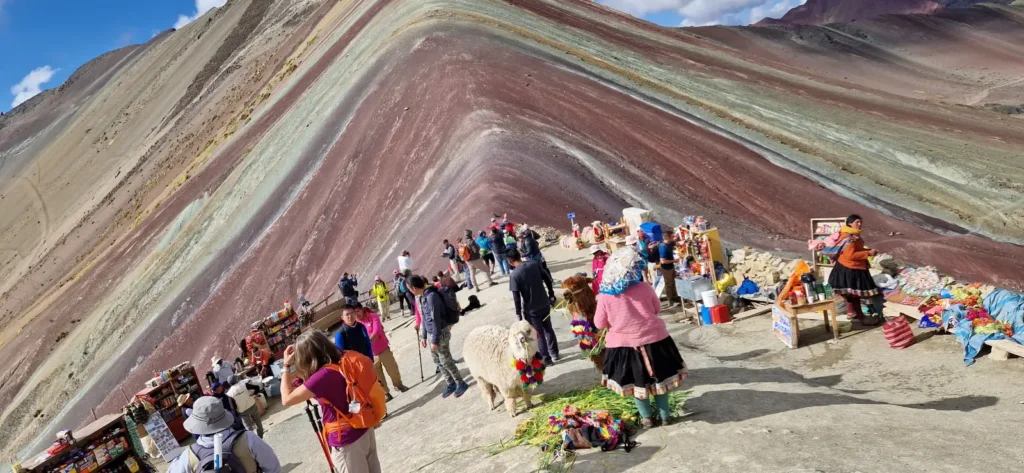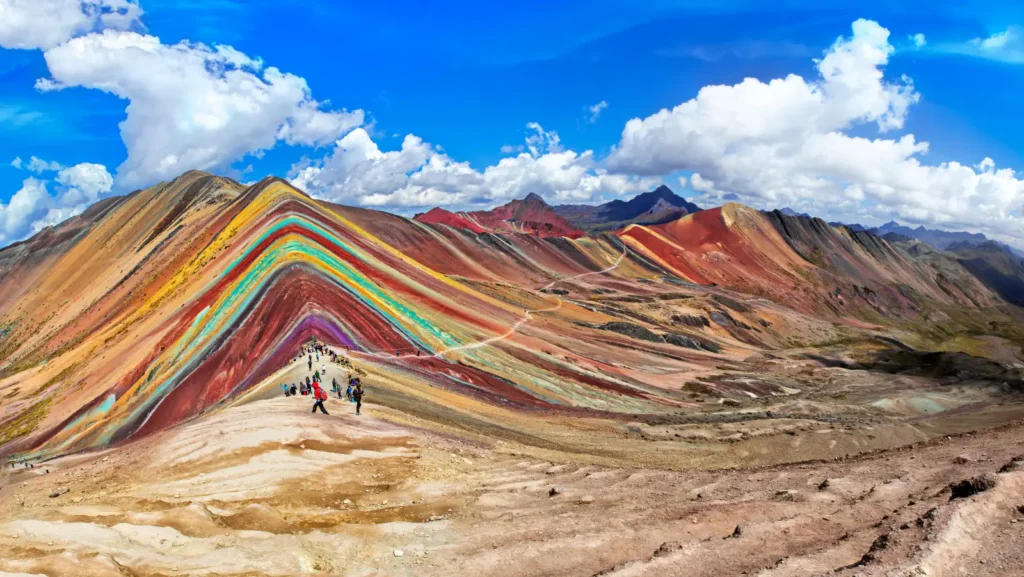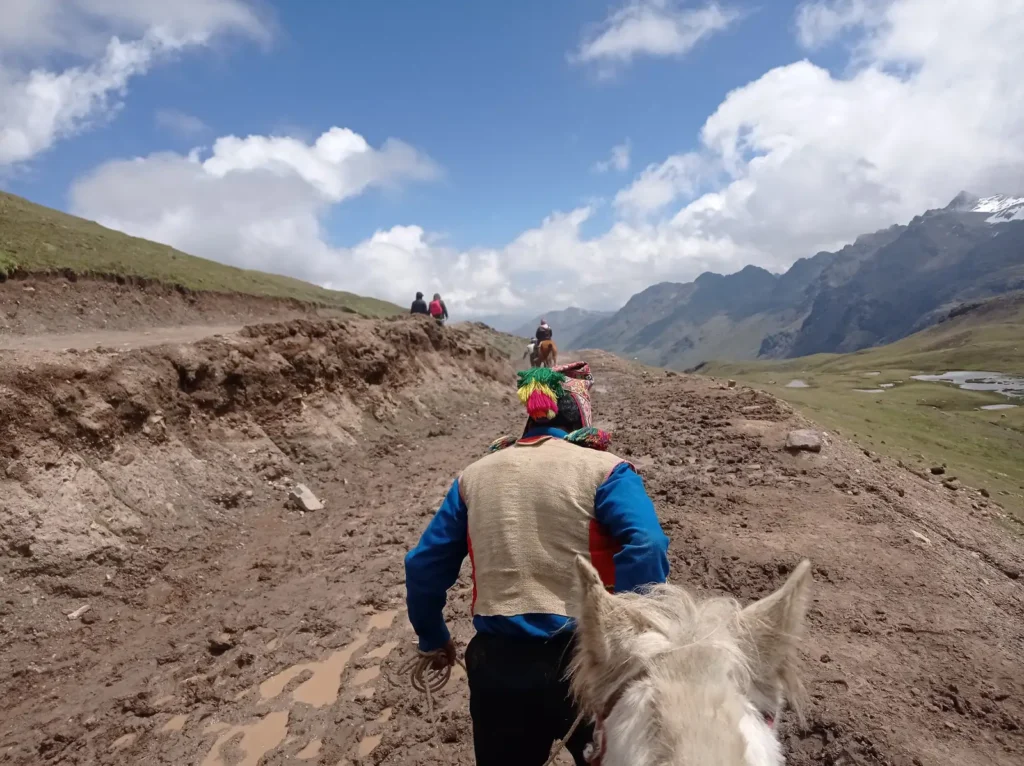High in the Peruvian Andes, more than 5,000 meters above sea level, stands a geological phenomenon that seems straight out of a dream: Vinicunca, popularly known as the Mountain of Seven Colors. With its vibrant stripes of red, green, yellow, purple, and gold, this corner of Cusco has become one of the most photographed—and coveted—destinations in Peru over the last decade.
But Vinicunca is much more than a backdrop for social media. It is a testament to the power of nature, a sacred place for Andean communities, and a physical challenge that rewards visitors with one of the most spectacular views on the planet.

Vinicunca is located in the Vilcanota mountain range, in the district of Pitumarca, province of Canchis, about 3 hours by car from the city of Cusco. The route crosses Andean landscapes of grasslands, lagoons, and small villages until reaching the starting point of the hike, near the community of Pampachiri.
Although many people know it as “Rainbow Mountain,” its original name in Quechua is Vinicunca, which could be translated as “mountain of wines” or “mountain of winds,” according to local interpretation. The name “Mountain of Seven Colors” emerged with the arrival of mass tourism, due to the impressive color palette displayed on its slopes.
Why does it have seven colors?
The colors of Vinicunca are not paint or an optical illusion. They are the result of geological processes that occurred millions of years ago. The different shades come from minerals present in the sedimentary layers:
- El Red and rust come from iron.
- Green is due to the presence of copper and marine fossils.
- Yellow and gold correspond to sulfur and limonite.
- Purple and violet are related to manganese and other compounds.
These layers, originally horizontal, were lifted and folded by the tectonic movement of the South American and Nazca plates, forming the Andes mountain range. Subsequent erosion exposed these strata, revealing the mineral rainbow we admire today.

How to get there and what to expect
The visit to Vinicunca begins in Cusco, where most travelers hire a tour or private transportation. After a three-hour drive on dirt roads, you arrive at the starting point, at an altitude of about 4,700 meters. From there, a 1.5 to 2-hour hike (one way) leads to the summit, at 5,040 meters.
The climb is moderate to strenuous, depending on physical condition and acclimatization to the altitude. It is common to feel fatigue, shortness of breath, or dizziness if you have not spent at least two days in Cusco before the excursion. Therefore, it is recommended to acclimatize beforehand and bring water, energy snacks, warm clothing, and sunscreen.
For those who do not wish to walk, it is possible to rent a horse with local muleteers, a popular option that reduces physical effort and directly supports the community.
Once at the summit, the reward is immediate: a panoramic view of the rainbow mountain, with the snow-capped Ausangate—one of the most sacred mountains in the Andean world—peeking out in the background.

TIdeal season to visit
The best time to visit Vinicunca is between April and October, during the dry season. During these months, the sky is clearer, the roads are firm, and the colors of the mountain are more vivid.
Between November and March, the rainy season can make the trail slippery, cover the mountain with fog, and, in some cases, even close the trail for safety reasons. Although the landscape is greener, conditions are not ideal for most visitors.
Impact of tourism and responsibility
Since going viral on social media around 2016, Vinicunca has received thousands of visitors a year. This has brought economic benefits to local communities, but also challenges: erosion of the trail, poorly managed waste, and pressure on natural resources.
That’s why it’s essential to travel responsibly: don’t leave trash behind, respect the designated areas, don’t touch or pull up vegetation, and choose tours that work directly with indigenous communities. Some operators already include local guides, transparent community payments, and sustainable practices.
Vinicunca vs. Palcoyo: which one to visit?
Many travelers wonder whether it is better to go to Vinicunca or Palcoyo, another colorful mountain in the same region. The main difference is in the difficulty of access:
- Vinicunca requires a longer and steeper hike at a higher altitude (5,040 m).
- Palcoyo has a shorter and gentler ascent (about 30 minutes), at about 4,900 m.
Both are impressive, but Vinicunca remains the most iconic and photographed. If you are in good physical condition and well acclimatized, it is worth the effort.
Essential tips
- Spend at least two nights in Cusco before going to Vinicunca.
- Avoid alcohol and heavy meals the night before.
- Bring cash to pay for the community entrance fee (around 10–15 soles) and horse rental.
- Hire a tour with insurance and a certified guide, especially if you are traveling alone.
- Be respectful: Vinicunca is not just a landscape, but a sacred place for the Andean people.
Conclusion
Vinicunca is not just a colorful mountain. It is an intersection between geology, culture, spirituality, and adventure. Its beauty is real, its history ancient, and its presence imposing. Visiting it requires preparation, respect, and humility in the face of nature. But those who do so return with an indelible image in their minds and a deep admiration for the Peruvian Andes.
If you are in Cusco and looking for an experience that combines extreme nature and unique scenery, the Mountain of Seven Colors should be on your itinerary. Just remember: it’s not about reaching the summit, but about doing so with awareness.
No comments:
Post a Comment